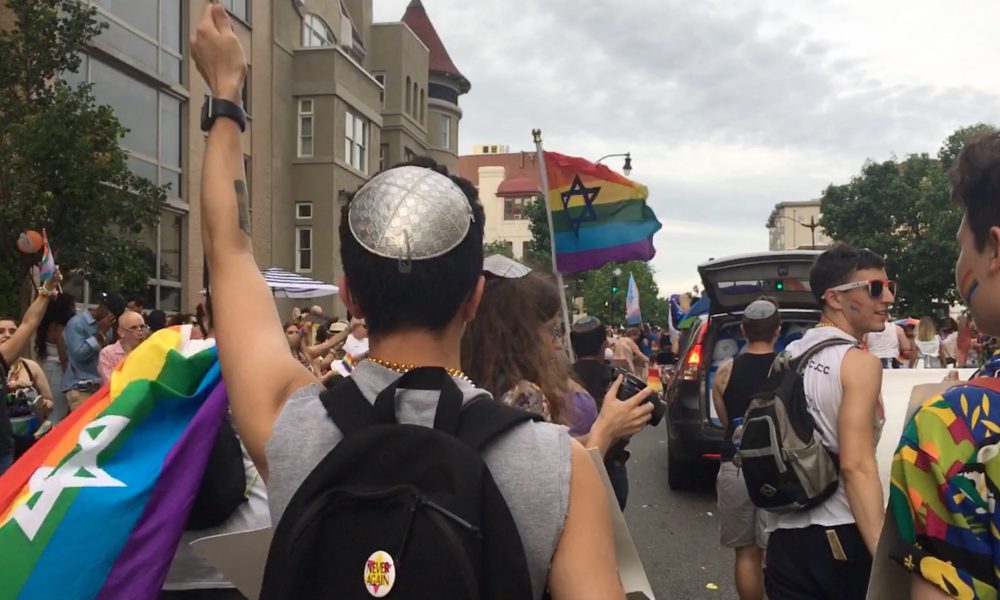I’ve worn a yarmulke in public every day of my adult life. While I can recall a few times when someone yelled at me or hurled an insult my way, these have generally been rare occurrences—except when I’m also holding my husband’s hand.
Existing in public as both Jewish and gay attracts a distinct level of attention, and with it slurs, stares and the rage of strangers. I’ve heard people mutter, or even scream, “Jew faggots” while my husband and I are crossing the street. The convergence of anti-Semitism and homophobia puts my safety at risk in a way that neither form of oppression could on its own. Recently, with the constant talk of rising anti-Semitism, we’ve been more vigilant than usual, and more likely to keep our hands at our sides.
A similar dynamic applies to anyone with multiple overlapping identities. For Jews of color, the combination of racism and anti-Semitism increases the risk of violence, whether the source is street harassment or police violence. For transgender people of color, either transphobia or racism might trigger an attack. The Human Rights Campaign found that one in four transgender people reported facing physical violence in 2019 and that black trans women accounted for the majority of transgender people killed that year.
Just as these dangers do not exist in isolation, American Jews’ response to anti-Semitism cannot be pursued in a vacuum. In a 2019 paper titled “Counting Inconsistencies,” four Bay Area researchers—three from Stanford and one from the University of San Francisco—found previous demographic studies of American Jews consistently undercounting Jews of color; they estimate that the real proportion is 12 to 15 percent and “will likely grow in size and significance in the coming years.” Millennials are far more likely than previous generations to identify as LGBTQ, a 2017 Harris poll found, and a 2018 Pew Research Center report calls Gen Z (people born after 1996) the most racially and ethnically diverse yet, with nearly half identifying as non-white.
Younger Jews know this from our own lived experience. For many of us under age 40, it’s self-evident that identity is complex and multifaceted. It’s not that members of older generations don’t have multiple identities; it’s just that we take this situation for granted. We are more likely to share communities with people who are non-white, queer or both. Our families are more likely to be multifaith and multiracial. We know that “Jewish” is not synonymous with “white,” any more than it is synonymous with “straight,” “cisgender” or “able-bodied.” That inevitably affects our view of anti-Semitism, complicating any assumption that anti-Semitism affects only a rigid, calcified category of people who are Jews and nothing else.
This is not to deny that anti-Semitism has a particular history, distinct from other hatreds. Rabbi Jill Jacobs, head of the human rights group T’ruah, has written recently of the long history of Jews used as “shields and scapegoats,” forced to act as vulnerable intermediaries between rulers and downtrodden classes—as tax collectors and other middlemen, for example—a dynamic that has ripple effects even today. Nor am I arguing that anti-Semitism is just one of many bigotries. It plays a key role in the ideology of white nationalism, as civil rights scholar Eric Ward has shown in extensive research on how anti-Semitism “forms the theoretical core of white nationalism.”
The danger of anti-Semitism is real, as we saw most recently in the New Jersey supermarket shootings. While we don’t know everything about the motives of those killers, we know that if we want genuine safety for the Jewish community, our response to anti-Semitism must also address the concurrent rise of xenophobia and white nationalism. This is not theoretical: The shooter at the Tree of Life Synagogue targeted a Jewish community that was advocating for refugees. Hatred of Jews and hatred of immigrants were combined with deadly results. We cannot allow a narrow understanding of who is endangered, and how, to cut us off from other struggles for justice. If we cannot recognize these intersections, we will not only fail to defend all people facing those threats; we will fail to protect ourselves.
In an ideal world, what would a conversation about anti-Semitism that accounts for the diversity of the Jewish community look like? It would resist elevating anti-Semitism above all other bigotries, leading to a double standard where Representative Ilhan Omar’s comments about “the benjamins” generate far more controversy than Representative Steve King’s long, unapologetic record of espousing white nationalism. It would not isolate anti-Semitism from other struggles for justice, particularly those fighting racism against black and brown communities. It would certainly not police language to the extent that Rep. Alexandria Ocasio-Cortez’s comments that migrant detention camps are “concentration camps” would elicit more condemnation than the existence of the camps themselves.
Finally, it would not react to incidents of anti-Semitism in other movements by abandoning those movements entirely—as too many Jews did when, for example, the Black Lives Matter movement used incendiary language regarding Israel’s occupation of the West Bank, or when Jewish groups were protested at the National LGBTQ Task Force’s Creating Change conference. Although these episodes are painful, and although we should continue to point that out, we cannot allow them to cut off our relationships with these movements for justice—not least because they are crucial to the dignity of Jews of color and LGBTQ Jews.
A truly effective conversation would acknowledge those overlapping burdens and learn from the ways our identities and experiences intersect. If that conversation were to happen across a wide spectrum of the Jewish community, it would benefit everyone—making us not just safer but wiser.
Sam Greenberg works in digital communications in New York.

